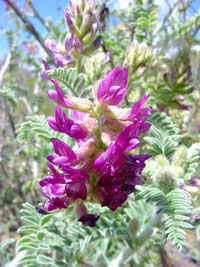 |
POLLINATOR PARTNERSHIP RESEARCH UPDATES
Grizzly bears like honey too! P2’s Pollinator Service CRP study is looking at how different conservation practices and seed mixes in the Conservation Reserve Program (CRP) impact native pollinators and honey bees.
 The spring bloom is winding down and making way for summer in the Santa Susana Mountains that sit between Simi Valley and Ventura, just north of Hollywood, in Southern California. Last week P2 scientists and field staff were out collecting data on the pollinators of Braunton's milk-vetch (Astragalus brauntonii) – an endangered species with a limited population at the Santa Susana Field Lab restoration site. The spring bloom is winding down and making way for summer in the Santa Susana Mountains that sit between Simi Valley and Ventura, just north of Hollywood, in Southern California. Last week P2 scientists and field staff were out collecting data on the pollinators of Braunton's milk-vetch (Astragalus brauntonii) – an endangered species with a limited population at the Santa Susana Field Lab restoration site.
Braunton's milk-vetch is a fire adapted species native to the coastal shrub lands of Southern California. Development and years of fire suppression have severely limited habitat opportunities. As part of our review of pollinator ecosystems at Santa Susana Field Lab P2 scientists are documenting the pollinator relationships of this endangered plant. Its bloom is short and seasonal, but its purple flowers are visited by carpenter bees, leafcutter bees, bumble bees, and honey bees. Knowing the plant-pollinator interactions of a species is essential for conservation and management. Background on this endangered species is very limited; our fieldwork is providing some of the first structured data on the pollinators of A. brauntonii.
North Carolina Farmers and Pollinators Get a Boost With support from Burt's Bees' The Greater Good Foundation, the North Carolina Bee Buffer Project is officially in the ground! The project brings together business and industry, government, academia and the non-profit sector to work with farmland across North Carolina to enhance pollinator habitat.
P2 Provides Much-Needed Assessment for Agriculture:
P2 examined four cropping systems in the United States to give a fair example of the current state and awareness of pollinator protection in agriculture. Almond, apple, and melon crops were chosen due to their dependence on insect pollination. The fourth crop, corn, though pollinated by wind, was chosen as a result of its extensive production and potential for contamination of toxic pesticides. Overall, BMPs during bloom are understood and pollinator protection is made a priority for most crop growers and applicators. Common practices include carefully reading product labels, night-spraying, and equipment maintenance. Protection methods in pre and post bloom periods are less prevalent, sometimes nonexistent. Resources available on a regional or state scope are inconsistent. This review focuses on, but is not limited to, honey bee protection due to their wide-spread use in many commercial cropping systems. BMPs for pest, fungus, and disease management can be designed to safeguard both pollinators and crop production. P2 hopes that this report will lead to the implementation of year round and geographic specific BMPs with an emphasis in communication and user friendly resources. This report will be made
|